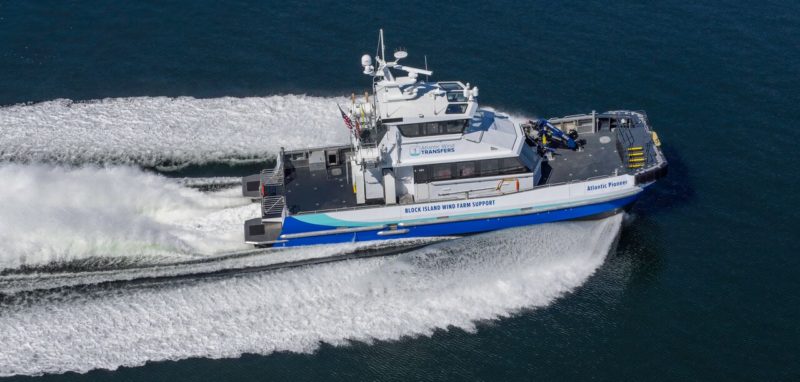The next generation of crew transfer vessels (CTVs) for the budding U.S. offshore wind industry could draw on European trends toward more speed, air cushioned hulls and even hybrid power.
But with groundbreaking possible on the first major U.S. project by year’s end, wind companies should already be looking toward those designs, builders said Wednesday at the IPF19 wind conference in New York.
“The big demand for CTVs is during construction, and you will need them long before you think you will” for early stages of moving generators and other equipment as well as workers, said Ian Bryan, interim managing director of CWind, a builder in the United Kingdom and major supplier to the European industry for a decade.
“There are plenty of (U.S.) companies just waiting for you guys to place orders,” said Luther Blount III of Blount Boats, Warren R.I., which in 2016 delivered the 70’6”x24’x4’ Atlantic Pioneer, the first, and to date only, U.S.-flag CTV for the Deepwater Wind/Ørsted Block Island Wind Farm.
But it takes 12 to 14 months to build such a vessel, subject to Coast Guard safety regulations and certification, Blount added.
“Please don’t wait until the last second. Give us time to build the boat,” he said.
European turbine operators’ needs for longer range, efficiency, better crew safety and comfort and safety has driven use of surface effect technology, building vessels that are crossbreeds of catamaran and hovercraft, said Svein Erik Myklandm, vice president of technology with Norwegian shipbuilder Umoe Mandal AS.
Air cushioned catamarans, derived from naval designs, can provide up to 80% weight lift for their carbon- or glass-fiber hulls, and higher speeds with one-third less fuel consumption, said Myklandm. Umoe Mandal’s Boarding Control System uses the air cushion system to control pitching to reduce fatigue and seasickness, and make it easier for technicians to board turbine towers.
“What’s really important is that you deliver those workers in a healthy condition. It’s no good if they’re green,” said Bryan of CWind. “You’ve got to be reliable, you’ve got to be on time…and they’ve got to be happy to be there.”

CWind's next-generation crew transfer vessel will carry 24 offshore wind technicians with hybrid power. CWind image
CWind’s next CTV is a 22-meter (72’) catamaran with capacity to carry 24 technicians with surface effect air cushioning. It will be hybrid diesel and electric power, with a battery boost providing an additional 9 tons bollard push when the boat noses up to a turbine from crew boarding, said Bryan.
“So it will be a leading class vessel, and a step toward a fully electric CTV,”
said Bryan. That is another growing imperative in the offshore wind market, as operators look for smaller carbon footprints in their fleets, he said. The new boat will be ready for charter to a European operator in May.
Blount Boats built the Atlantic Pioneer to a design licensed from South Boats IOW, another U.K. shipyard well established in the European wind industry. Other builders have said they are ready to build boats by both U.S. and European naval architects.
One question is whether the European influence in the offshore wind industry will lead to developers preferring society classification over Coast Guard certification for the vessels. That will depend on the contract tenders from buyers, and can add 10% to 15% to vessel costs.




